We may earn a commission from the affiliate links on this site. Learn more›
It’s been five years since the release of the Alesis Strike MultiPad—does it still hold up in 2023? Today I’ll review the unit and give my opinions of the sampling pad.
Alesis hasn’t released a new sampling pad yet, despite Roland dropping the SPD-SX Pro last year. And before that, the Strike MultiPad decimated the original SPD-SX in terms of sounds, playing capability, build quality, and design.
Let’s see if it still holds up.
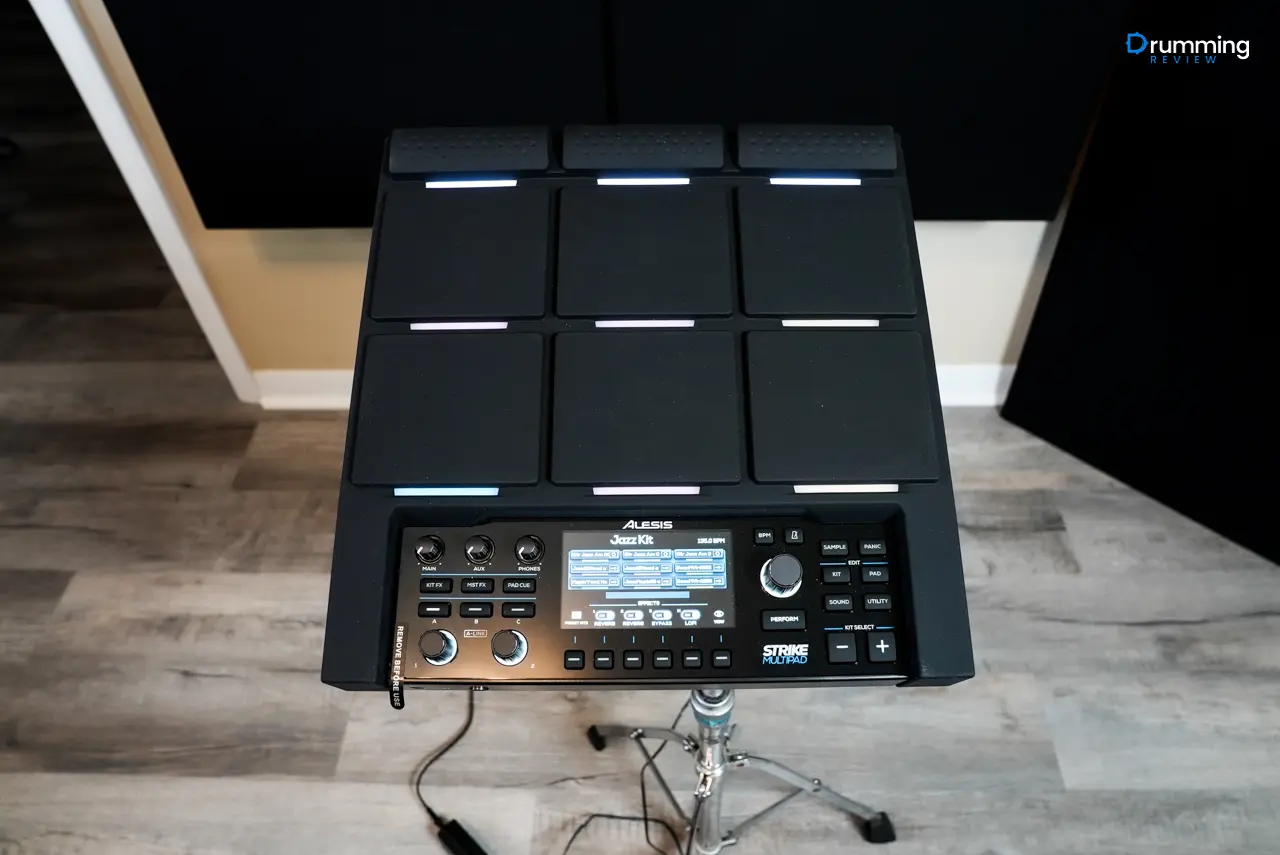
Quick look
Alesis Strike MultiPad
- Pads: 9
- Storage: 32GB
- Function: Sampling, triggering, looping
- Sounds: 8,000+ pre-loaded samples
Why pick the Alesis Strike MultiPad?
The Strike MultiPad is perfect for drummers who want to add additional drum samples to their performances without breaking the bank. The closest rival, the SPD-SX Pro, retails at $300 more than the Strike MultiPad. With 8,000+ pre-loaded samples and 32GB of onboard storage space, you'll have no problem recreating all the moments from the studio.
- 32GB internal storage
- Customizable LEDs
- 8,000+ pre-loaded samples and loops
- Ability to record samples from any source (phone, microphone, USB)
- Potentially nearing the end of its life cycle
- UI has a learning curve
Alesis’s prior drum pad, the SamplePad Pro, was far inferior to the SPD-SX and I can tell that they have done their homework in creating a far better product both for beginning drummers and professionals.
The Alesis Strike MultiPad ships with both a copy of Ableton Live Lite for all you budding producers out there.
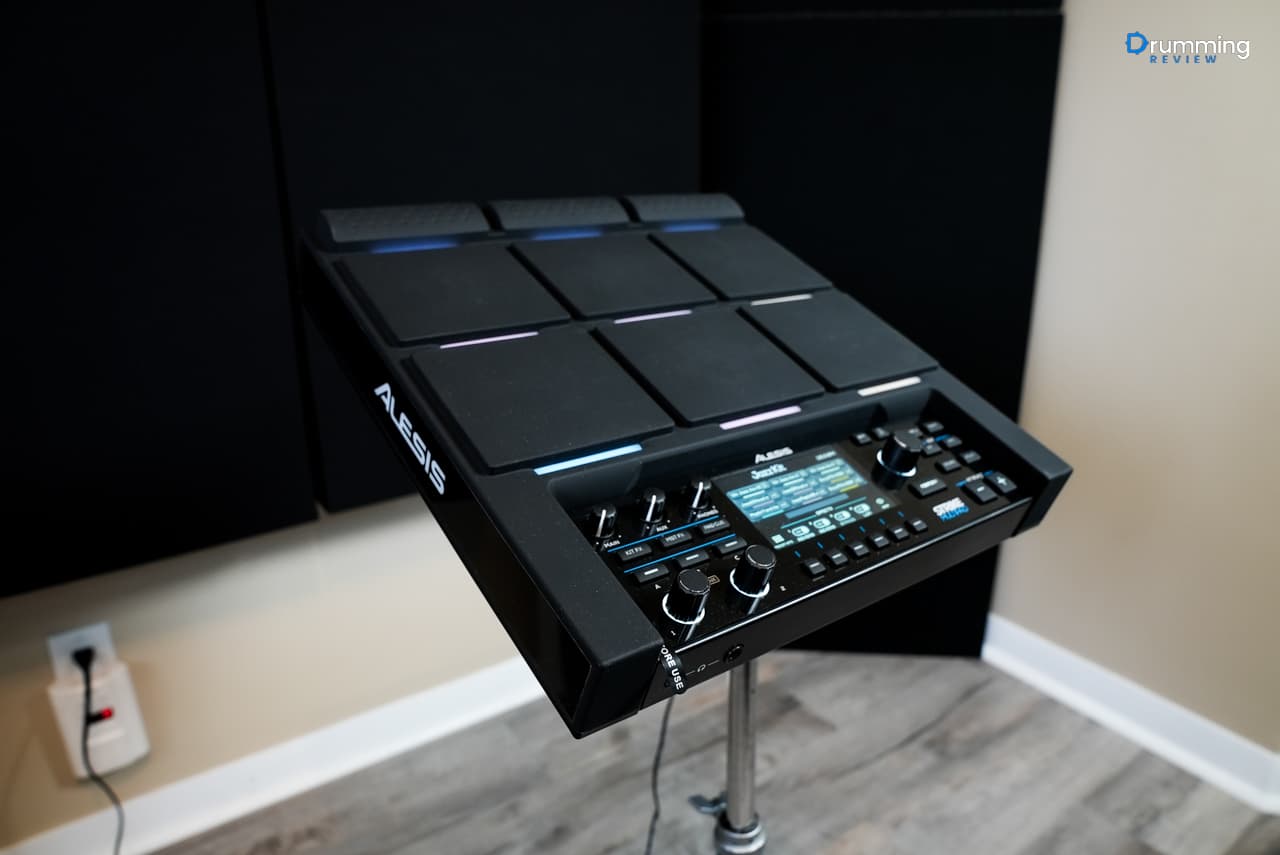
Let’s take a look at some of the main selling points.
- Nine velocity-sensitive pads with customizable RGB lights
- 5 built-in effects processors
- Expandable to an additional 3 drum triggers, a hi-hat pedal, and two dual foot controls
- 8,000+ pre-loaded samples
- 32GB of internal storage
- Ability to record samples from any source
- On-board looping software
- Built-in audio interface
Whew. There’s a lot of great features here. Let’s dive in.
Overall appearance
Right off the bat, I was very impressed at the cool factor given off by the Strike MultiPad. It looks far better than its predecessor.
The build quality is superb and compared to the SPD-SX Pro, the Strike MultiPad retails at a price $300 cheaper.
It feels good to the touch, as well. The top panel is entirely made of a silicone, rubber material. The unit screams quality.
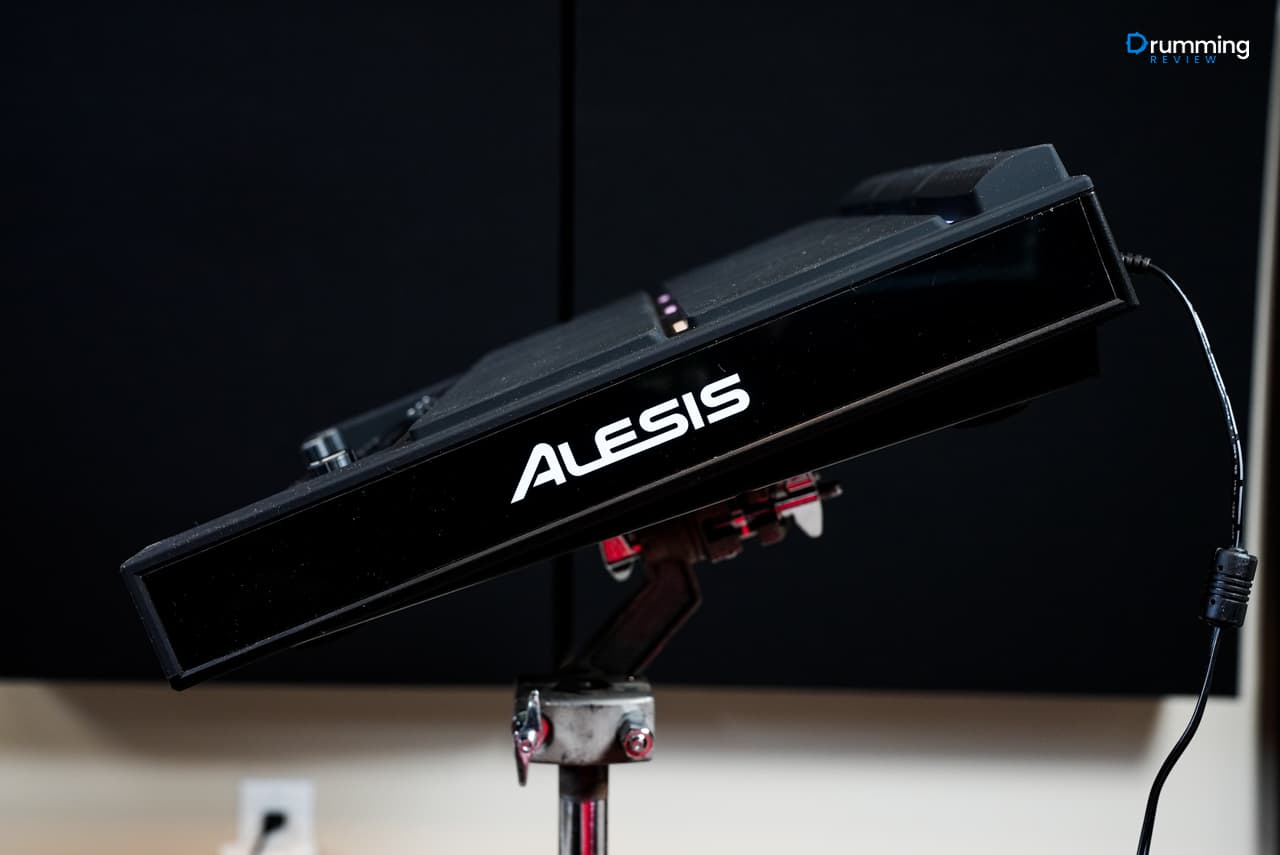
Lights
The nine LED indicators look great and give you visual feedback while playing the pads, something the SamplePad Pro desperately needed.
The LED lights also function with loops, so you can see if one is actively running. You can see the entire progress of the loop on the indicator as it plays.
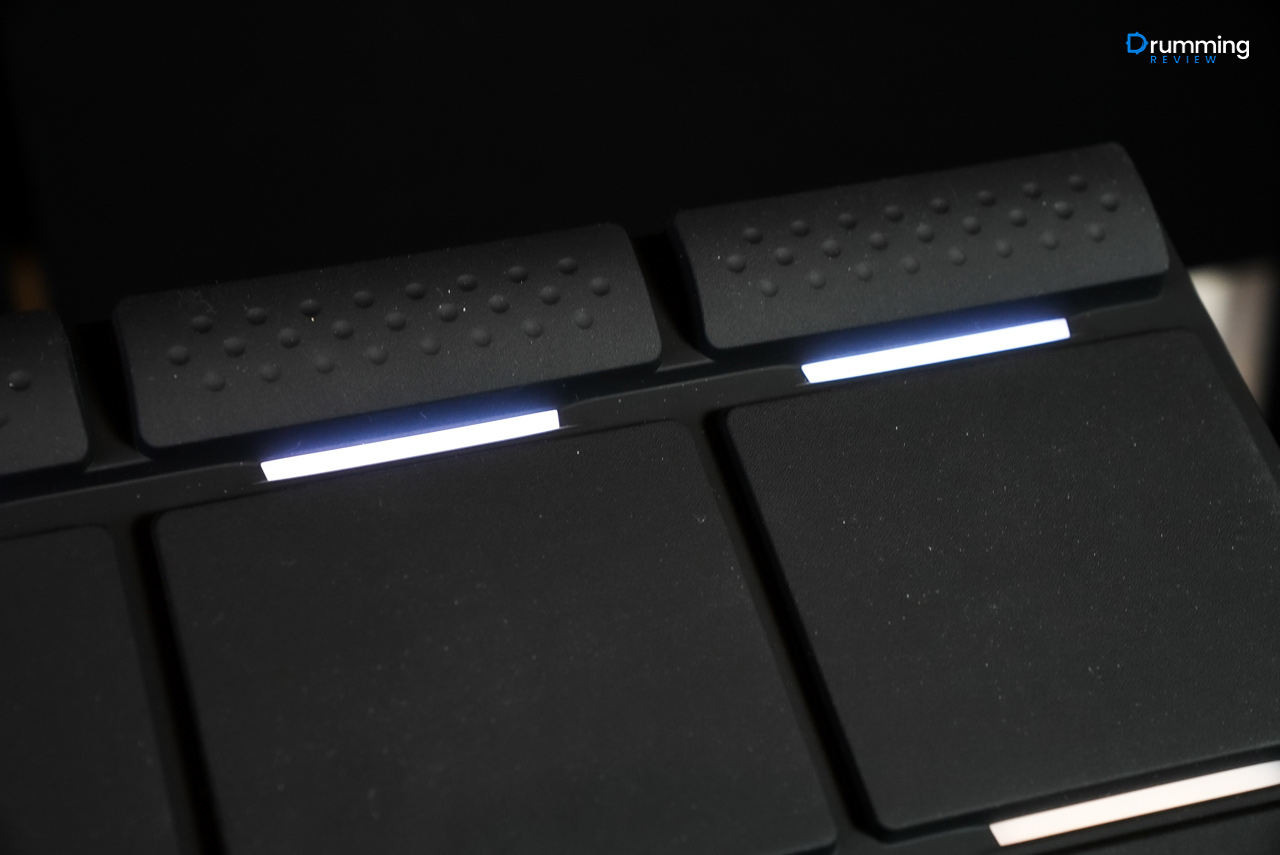
If for some reason you cannot hear your pad in the nightmare scenario of a bad in-ear monitor mix, at least you’ll have a visual representation of what your drum pad is doing.
In addition, you can change the color of each light as well as its animation. This allows for amazing visual feedback given the ability to change a given pad’s animation.
There are twenty different colors and several different modes to display on each pad.
Display
Smack dab in the lower center of the unit is a 4.3″ color display, and it looks rather nice.

It’s very clear and is large enough to display a great deal of information without feeling overwhelming. Navigating the menus and editing samples is no problem.
Storage
The Strike MultiPad boasts a whopping 32GB internal storage drive, allowing you to bring all the custom samples you’d like to your next gig.
The SPD-SX Pro also has 32GB of internal memory, but costs $300 more.
In addition to its large storage capability, the drum pad ships with 8,000+ pre-loaded samples which are both pitched and percussive.
Samples can easily be loaded on the Strike MultiPad via USB and a computer or with a USB thumb drive. If for some reason you fill up all 32GB of storage, you can also add an external SD card for more room.
Sounds and sampling functions
Being that the pad ships with 8,000+ sounds, there have to be some good ones in there, right?
There are. A ton of great ones actually. Some of my favorite sounds included are actually synths (specifically on the Pluck This! preset).
They work great with the looping functionality. It’s super easy to jam along with an acoustic drum kit with this pad.
Preset kits
I found the included samples to be very impressive and usable. There’s a well-rounded diversity of sound samples: lots of electronic, acoustic, orchestral, world and more.
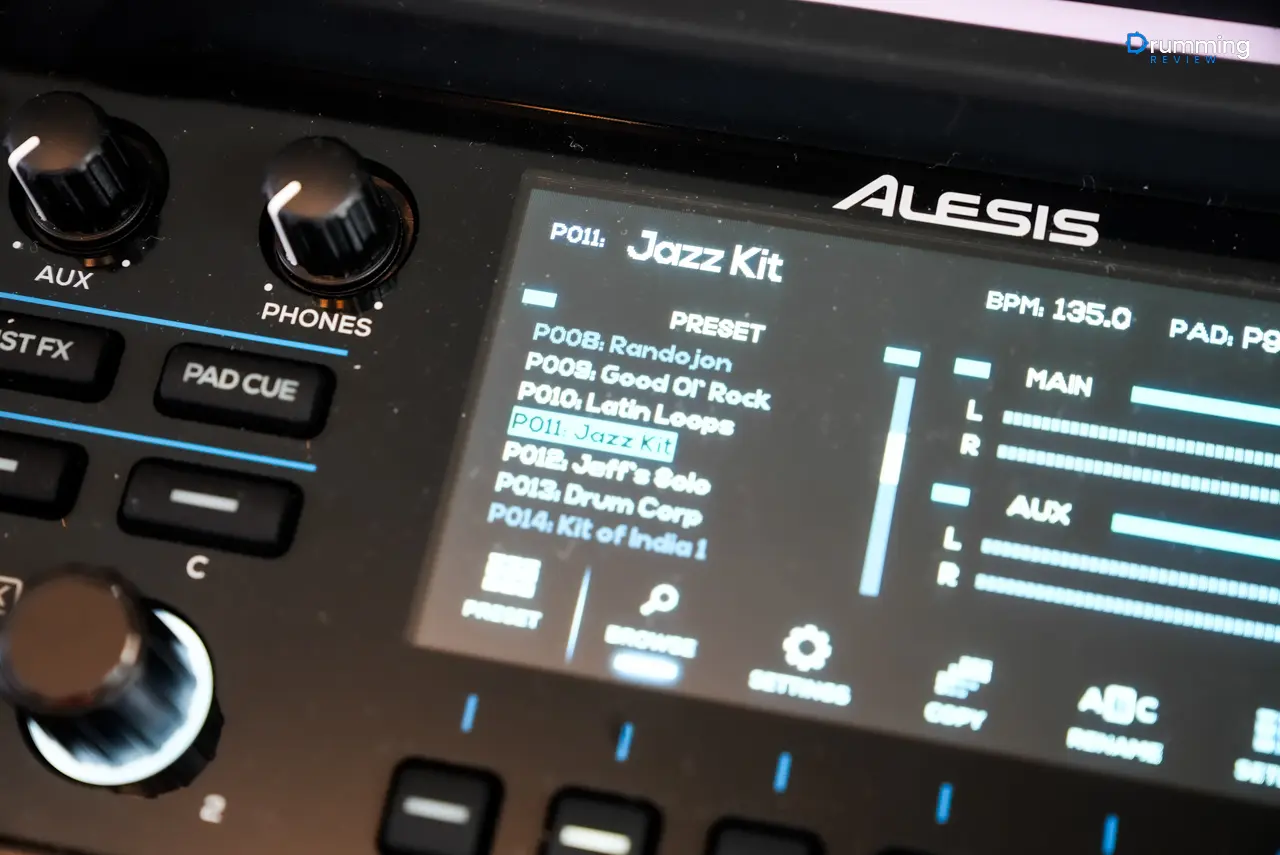
Upon loading the unit up, you’ll find 30 preset loaded kits available to choose from and 70 empty user kits for you to customize.
The stock Cash Money Kit is reminiscent of the Roland 808 kit. Knife Jogger is a great kit for film production, though I’m sure you’ll be using more than just the samples from your Strike MultiPad if you’re in this world.
The acoustic drum samples included with the Strike MultiPad sound incredible. They’re so good, in fact, you could use them on a record and no one would know they came off of a sampling pad.
The Good Ol’ Rock preset is one of my favorites. And the Pink Tom Phils preset is perfect for anyone who wants to get their fill of Phil Collins.
Timpani is an orchestral patch with, you guessed it, timpani. I suppose it’s useful if you want to add a few orchestral elements to your set.
There are also preset patches like Latin Loops that feature various looped percussion you can jam over, including congas, bongos, and shakers.
One neat trick with some patches is the top right pad. Hitting this will trigger a high-pass filter, creating an EDM-like effect prior to a big drop.
You can add this to any kit on any pad, but you do lose the ability to place a sample on that given pad. The Ham & Beans preset is a perfect kit to try this out on.
Sampling your own sounds
Recording your own samples is easy. Whether it’s from your iPhone or any other source, you can do it with ease. Editing them is a little more time consuming, however.
Once you have a source plugged into the auxiliary in, it’s as simple as clicking the ‘Sample’ button, choosing the source as ‘Record in’, and you should see some signal to the meters.
Adjust gain accordingly.
Once you’re ready to sample, press ‘Arm to record’, hit ‘Record’ and play your sample. When finished, press ‘Stop’.
Editing samples on the Strike Multipad
Once saved, you will now need to edit the waveform so the initial transient begins when you hit your pad.
Editing the start and stop points done by using the two left rotary knobs. Be sure to use the zoom function to get as close to the start of the wave as you can.
Use the ‘Play’ button to see how you did editing. If the volume seems a little low, you can use the normalize function to bring it to the level of all the other samples.
This can be a little bit tedious to do on the sampler, so you may want to edit any additional samples in a DAW prior to importing them to your sample pad.
A + B sample function
A new feature being introduced by the Strike MultiPad is the A + B sample function. This allows you to have two samples linked to one pad.
They can either play together at the same time or alternate between the two.
Of course, you can take this concept much farther inside a DAW with a computer, but it is nice to have a standalone feature such as this.
The Looper
The Alesis Strike MultiPad also features an awesome looping function. You can record your performance and overdub up to sixteen measures.
In addition to looping samples from inside the unit, you can also loop sounds from the audio input on the back of the unit.
You can plug in a microphone, keyboard, guitar, mixer, anything you can think of.
I don’t believe the looper function quantizes your performance to a grid-like Ableton Live does, so make sure your playing is on point.
Inputs and Outputs
Another impressive section of the unit is the back panel of inputs and outputs. The connectivity of the Strike MultiPad is far superior to any other pad available currently.

Here’s what the inputs and outputs look like.
- 1/4″ stereo (L R) record input
- Two foot control inputs
- Stereo auxiliary output
- Stereo main output
- Trigger input (5)
- Hi-hat input
- MIDI in/out
- USB to computer
- USB memory stick for loading samples
Tons of trigger inputs
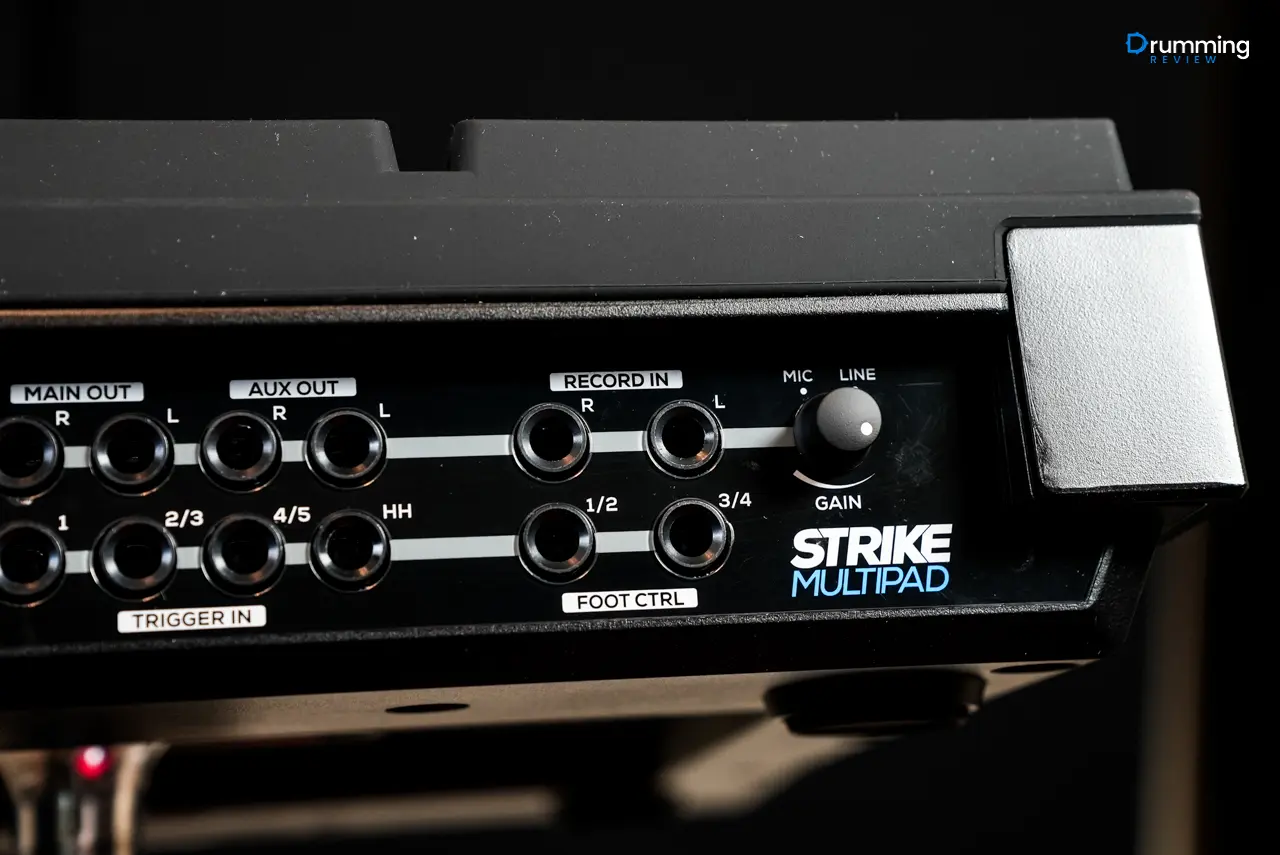
I honestly couldn’t get over the number of trigger inputs that are available on this pad. You can have a major setup with controlled all by just this one unit.
Two of the trigger inputs are dual-zone and one is mono; you can really get creative with the types of additional trigger pads you add to your sample pad.
Auxiliary output
The auxiliary output is also great for running backing tracks internally with samples imported to the unit. You can also run a click track to just your mixer—this function makes it super easy.
Another scenario would be to have backing tracks from a laptop use the aux out, while sounds from the drum pad come through the main outputs.
You can easily control the volume of the tracks and the drum pad with the knobs on the left-hand side of the pad (don’t touch them once they’re set at soundcheck unless you want a mad sound engineer).

The only thing this pad could improve upon I/O wise would be a traditional 3.5mm audio input jack for playing along with your favorite tunes. Unfortunate that we have to use an adapter, but that’s not too big of a deal.
The headphone jack is located on the front of the unit and you can either use a 1/4″ jack or a 3.5mm jack… Seems like this may have been the perfect spot to put the auxiliary input on the front.
Audio interface
In addition to all the great features mentioned thus far, the unit also functions as an audio interface (2in/2out).
There are two mono line inputs on the back of the unit. If you want to use microphones with the pad, you’ll need the appropriate adapters.
Using the Strike MultiPad with backing tracks in Ableton Live
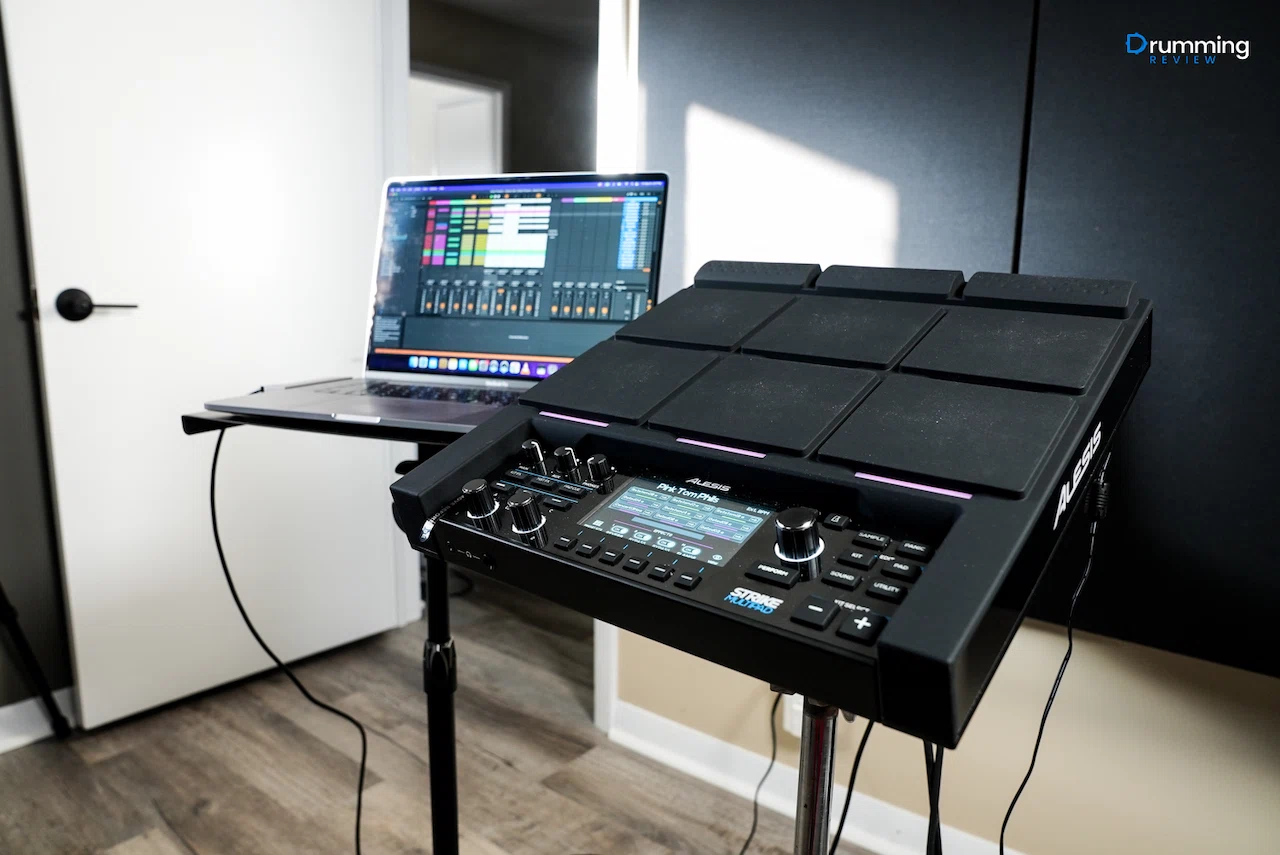
My final test was to see how the Strike MultiPad worked with backing tracks. I was curious if you could run tracks without the need for an external audio interface. The answer is yes, however, you’ll be limited on the number of outputs you can send to front of house.
Also, I wasn’t able to figure out a way to route the click track channel from Ableton specifically to the PHONES output of the Strike MultiPad. Maybe someone in the comments can enlighten me on how to achieve this!
For my setup, I use another audio interface with my backing tracks, since we send multiple stereo outputs to front of house, so the Strike MultiPad is acting as a MIDI controller only. No sounds come out of the pad in this scenario.
To use the Strike MultiPad as a MIDI controller exclusively, you need to navigate to Utility -> MIDI -> and ensure Local Control is set of OFF. This will disable all onboard sounds from playing through any outputs, so you’ll need to re-enable this feature if you want to use the pad like normal.
The Strike MultiPad was immediately recognized in Ableton and I was able to program all my control changes in a matter of seconds. The GIF below shows me switching between songs in our setlist.
For drummers who want to exclusively use a sampling pad for controlling Ableton, you may want to save yourself some money and get the SamplePad Pro.
The Strike MultiPad may be a little overkill in this regard, but one thing’s for sure—it certainly can take a beating and will hold up traveling in and out of clubs and theaters.
Who needs an electronic drum pad like the Strike MultiPad?

There’s a few types of performers I can see benefiting from adding an electronic sampling pad to their setup:
- Drummers playing in bands using backing tracks
- The Strike MultiPad makes it easy to either import full backing tracks or use the pad alongside a laptop with playback software
- Music content creators seeking an easy way solution for recording with extra sounds
- Using the Strike MultiPad as their main audio interface, musicians of all kinds can send all their microphones from a mixer to the Line Inputs on the pad, monitor their performance with headphones with the unit, and record to a DAW with either a laptop or compatible device
- Musicians who want to trigger loops alongside their instrument
- Acoustic guitar players can benefit from the pad, as it’s easy to trigger loops for songs without requiring additional musicians on stage. Loop pedals are limited and the Strike MultiPad has endless possibilities for creating an exciting and engaging performance, no matter the venue
Final thoughts
Alesis stepped up their game five years ago and the pad is still a winner for professional drummers. It’s high-quality, affordable, robust, and won’t let you down at performances. Had this pad been around when we started touring back in 2014, I would have snagged it in a heartbeat.
Being that the unit comes with a copy of Ableton Live Lite, I can see many drummers in bands using this sample pad to introduce backing tracks to their live performance.
The looping functionality is great and the ability to overdub samples in real-time from the unit standalone is superb.
It’s definitely a step up in price when compared to the SamplePad Pro, but with the added features and build quality, I believe it’s justified.
And compared to the SPD-SX Pro, it’s no question. The Strike MultiPad is a far better value.
Alesis Strike MultiPad
- Pads: 9
- Storage: 32GB
- Function: Sampling, triggering, looping
- Sounds: 8,000+ pre-loaded samples
Why pick the Alesis Strike MultiPad?
The Strike MultiPad is perfect for drummers who want to add additional drum samples to their performances without breaking the bank. The closest rival, the SPD-SX Pro, retails at $300 more than the Strike MultiPad. With 8,000+ pre-loaded samples and 32GB of onboard storage space, you'll have no problem recreating all the moments from the studio.
- 32GB internal storage
- Customizable LEDs
- 8,000+ pre-loaded samples and loops
- Ability to record samples from any source (phone, microphone, USB)
- Potentially nearing the end of its life cycle
- UI has a learning curve
Interested in other options? Read up on our roundup of the top electronic drum pads here.
Alesis Strike MultiPad
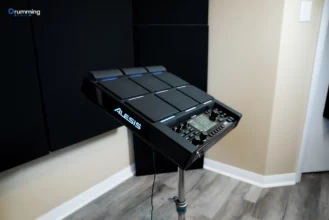
The Strike MultiPad holds up well still, even competing with the newer SPD-SX Pro from Roland. It's more affordable, has tons of great features and is packed with incredible sounds that will keep the busiest drummers excited to tinker with the sampling pad between gigs and in the studio.
Product Brand: Alesis
4.4
Pros
- Quality and robust design
- Affordable compared to competitors
- Tons of usable sounds included
Cons
- UI has learning curve


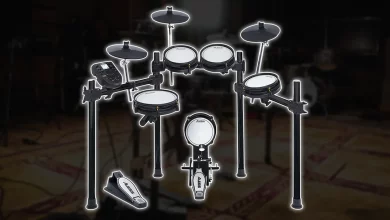
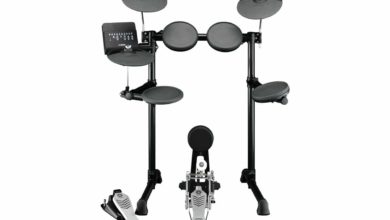
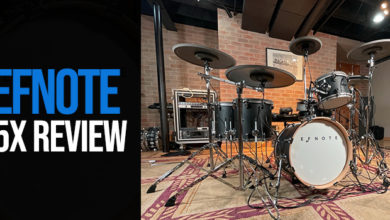
How good are the velocity sensitive pads? Are they working same good as Roland octopad or similar products?
0
Hi Peter. Thanks for dropping a comment.
I think the pads are pretty much on-par with Roland’s SPD-SX and Octopad. They are a much-needed upgrade when compared to the Samplepad Pro.
If you have doubts though, nothing beats taking a trip to a local music store and trying one out for yourself. Most Guitar Center’s are carrying the MultiPad now. Cheers!
0
Had mine for about a week and am already disappointed by a few important things (to me)
1. No quantize/snap function for loop recording either during recording or playback
2. When you start recording a loop, you have to wait for a 1 bar count-in. I much prefer the Roland SPD-s process which arms record and gives a click, but doesn’t start recording until you actually strike a pad.
3. Would love to have a “live record” loop function (similar to Wavedrum Mini or the latest Roland Handsonic) where you are able simply and quickly record a phrase without having to set up tempo or bar length etc.. Great for capturing “on the fly” loops in real time.
4. Cannot match sampled loops to clock/tempo sync (like in Ableton). Loops only play back at tempo recorded
5. No ability to have sampled loop phrases start playback on the nearest beat/bar etc… If you don’t hit the pad exactly in time you loops will be out of sync.
6. No way to sync FX such as delay to clock/tempo
Why can’t someone just come out with a drum pad hardware version of Ableton Live????
0